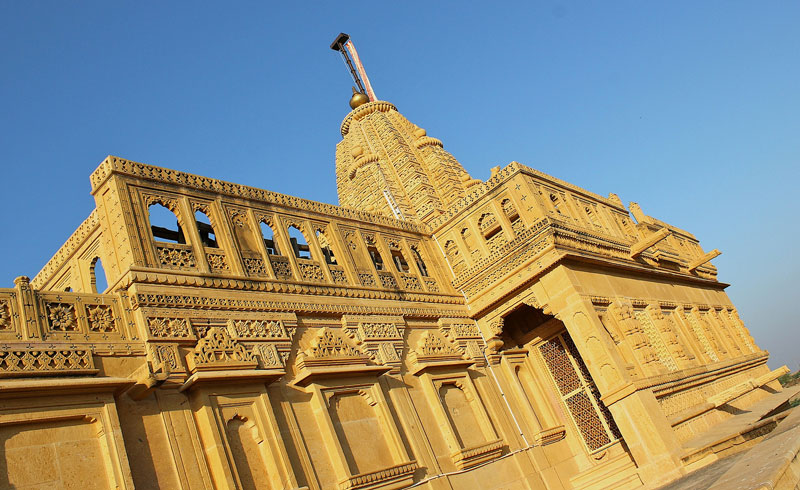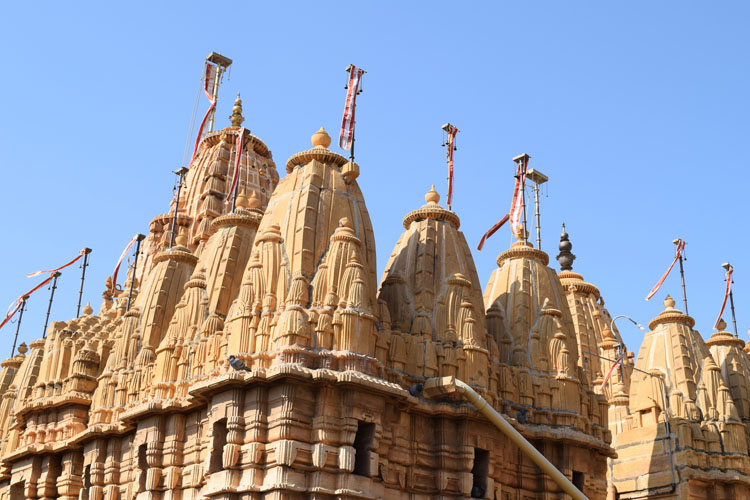Visitors Information
- Famous For: Spiritual devotion, Architectural aesthetics, History, Photography
- Entrance Fee: Free for Indians and 10 rupees for foreigners. 50 INR per still camera and 100 INR per camcorder.
- Visiting Time: Early morning to noon
Jaisalmer is subsumed by the golden sands of time that sparkles with memories and tales of valiant heroes, religious ascetics, beautiful princesses, conniving kings and clever ministers. The architecture of the city is a mere reflection of the barren beauty that surrounds it. The yellow sandstone that makes up the image of the Jaisalmer Fort emulates the environment it stands in. Inside this formidable structure stands the Jain temples. The Jain temples are a cluster of stories that are unravelled in stone. Stories that are narrated by the multiple sculptures, that cover every surface of the temple. These temples are the testaments of a philosophy that today, has taken the shape of a flourishing religion, that has taken roots in almost all parts of India.
Traveller’s Tips
- Try to minimise the leather that you carry in the form of bags and belts as you would have to open all of this before entering the temple premises
- Make sure to reach their early in time so you have enough time to cover the temples. The temple is strict about not letting non-Jains enter after 12 as that slot is reserved for devotees.
- Keep an eye out for the intricate symbolism that accompanies each temple. It would help widen your knowledge base and is a treat to the eye.
- If you are visiting the area during summers, then make sure to protect yourself from the scorching heat and keep a water bottle with you at all times.
About the Temples
- The complex has many temples that are similar in architecture but venerate different tirthankars. In Jainism, the tirthankars are spiritual gurus who help guide one through the universal existence.
- The first temple in the complex worships the eight tirthankar Chandra Prabhu. The temple uses the symbol of the moon to represent the tirthankar himself.
- The complex also has the temples of Parasnath, Shitalnath and Sambhavanth.
- The temples are built in the Dilawar form of architecture that is also represented in the temples in Mount Abu.
- At one point in the day, you can see the priests bent over their grinders and mortars, grinding sandalwood to a fine paste. Their hard work seems to reach all the corners, in form of the sweet fragrance of the paste thus formed. This sandalwood paste is used for spiritual purposes.
Guides
You may find guides who are willing to show you the temple complex, but we would advise you to forgo the guides. The beauty of the temple can be observed without the rampant ranting of the guides. But, if you are interested in knowing minute details of the place you might find the guides helpful in some sense.
How to Reach
Jaisalmer is a small town where all distances are covered easily. You may find it easy to just hail an auto or a rickshaw from outside your hotel to the fort. The temple lies in the fort complex.
Best Time to Visit
The best time to visit the area would be during spring or winter times. In the months of May, June and July the temperatures are skyrocketing. Touring the city during this time can be rather uncomfortable, with the noon being completely unbearable. If you are visiting the city during the summer season make sure to carry hats, sunglasses and water bottles.
Nearby Attraction
- As mentioned earlier the Jaisalmer Fort would be a part of the trip, if you are visiting the temples as the temple does lay within the fort premises.
- The Gyan Bhandar library also falls near the temple complex. The library has some interesting works on ancient architecture. Any student of history or architecture might find the library an interesting visit.
The temple is a must visit for anyone visiting Jaisalmer. The temple still attracts devotees from all over the world. The temple acts as a confluence of both art and devotion, much like many other famous temples in the country.



